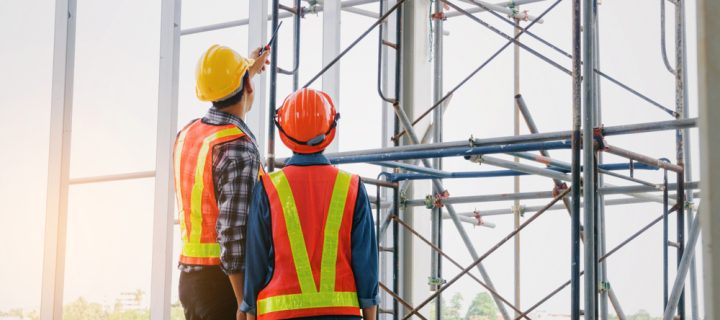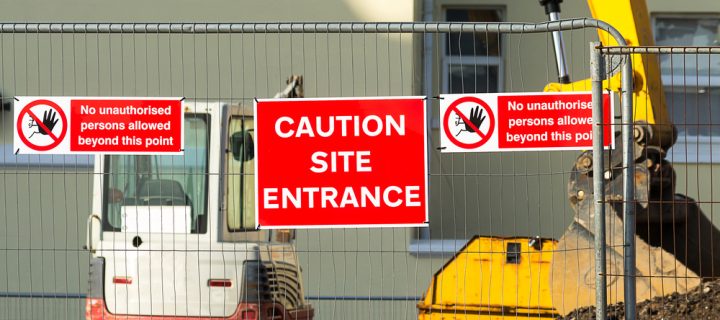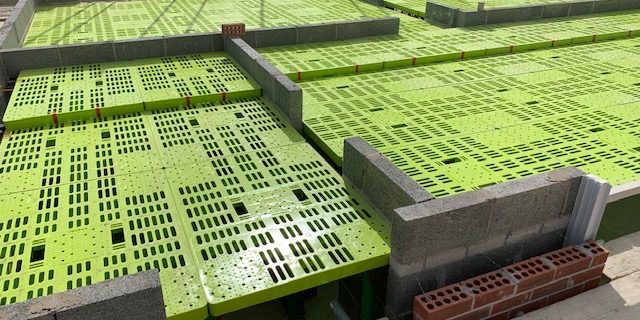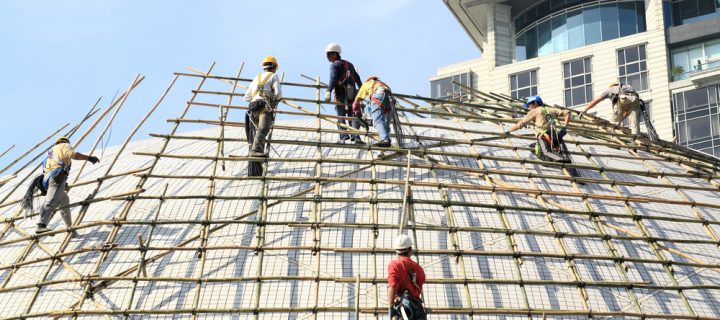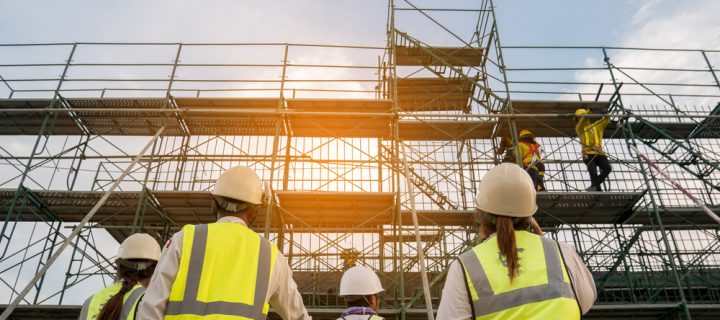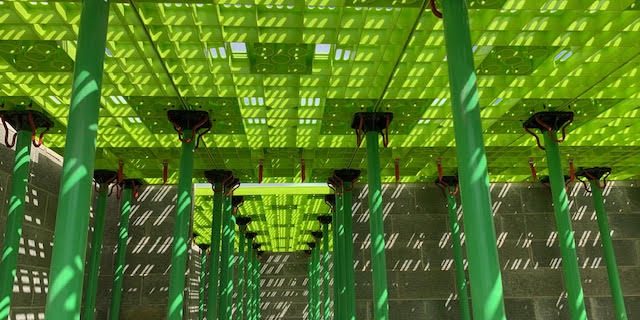Scaffolding provides a safe and stable platform for construction, maintenance and repair work. However, what many individuals might not realise is that scaffold towers and systems have specific weight limits which must be complied with. As a scaffolding company, we believe it’s critical to understand these scaffold weight limits when working on any construction project, whether you work as a scaffolder or a construction project manager. In this article, we will explain the maximum scaffold weight limits, the influencing factors and the risks of exceeding them. Understanding Scaffold Weight Limits Scaffold weight limits refer to the maximum amount of weight a scaffold system can safely support without compromising its stability. These limits are vital to ensuring the safety of workers as well as the successful completion of the construction project. According to the Health and Safety Executive, weight limits for general access scaffolding can be divided into four main categories: Very light-duty scaffolding can support loads up to 0.75 kN/m² Light-duty scaffolding can support loads up to 1.50 kN/m² Medium-duty scaffolding can support loads up to 2.00 kN/m² Heavy-duty scaffolding can support loads up to 3.00 kN/m² Factors While the above weight limits are only a guideline for access scaffolding, there are a number of factors which can influence scaffold weight limits. These include: Scaffold Type – Different scaffold systems are capable of supporting different load capacity. For instance, shoring scaffolding is designed to support heavier loads than access scaffolding. Materials and Equipment – The weight of materials and equipment placed on the scaffold must be within recommended limits. Number of Workers – The number of workers on the scaffold system can affect the overall weight limit. Local Regulations – Adhering to local regulations and building codes is non-negotiable. They often take into account factors such as climate, seismic activity and other site-specific conditions. These regulations may differ for scaffolding in your area. Scaffold Condition – Regular inspections are vital to ensure the scaffold system remains in good condition. Damaged or weakened parts can significantly reduce the scaffold’s weight-bearing capacity. To determine the maximum weight limit for your scaffold system, you will need to consider these factors and calculate the added maximum weight on your scaffold system at any...
Read Moreabout What Are Scaffold Weight Limits?When your building is under construction, the premises can be put in a vulnerable position. Therefore, one of the important things is keeping your site as secure as possible. If a site is not secured properly, members of the public or children can gain unauthorised access and risk an injury occurring from falling objects or attempting to climb your scaffolding structure. Another reason you need to keep your site closed off is to prevent vandalism and damage being caused to your site. For those reasons, it is crucial to prevent unauthorised access at all times, not only during the day but also outside of working hours, as these incidents could happen at any time. This may lead you to ask the following question: how do I prevent unauthorised access to my site? Here are 3 effective ways to achieve this. 1) Access Control Implementing access control measures can add an extra layer of security including locked gates or key-coded entry systems. By restricting access to only authorised personnel such as construction workers, you can prevent unauthorised individuals from entering your site. This provides a basic level of security. However, locked gates can be vandalised or climbed over, thus giving unauthorised access so you will need to add additional safety measures to increase the level of security. 2) Carry Out Regular Inspections Regular inspections and monitoring help to detect any signs of unauthorised access and trespassing. This can involve assigning someone or hiring security staff to regularly check the site and scaffolding for any unusual activity. By promptly identifying and addressing any potential breaches, you can ensure the safety and security of your site. Alternatively, installing CCTV cameras around your site can provide you with 24-hour surveillance. With modern technology, the latest CCTV systems allow you to view real time surveillance of your site from a remote computer, tablet or mobile phone. 3) Plastic Hoarding Secure the site by setting up some form of physical barrier around the scaffolding area. These can be sturdy fencing, barricades or plastic hoarding. Plastic hoarding refers to the use of plastic sheets or panels to create a temporary barrier or enclosure. It is commonly used on building and construction sites to separate the work...
Read Moreabout 3 Ways To Prevent Unauthorised Access To Your SiteCrash decking, or crash deck if you want to use its shortened name, is an industry leading fall prevention system. Luckily, this industry leading system is provided by Network Scaffolding Ltd. While the term might sound quite aggressive and/or worrying, the crash deck is by far one of, if not the most, useful tools in a scaffolder’s health and safety regulators arsenal. All the way back in late 2020 we covered some of the many perks of crash deck scaffolding, however, we thought it might be about time to reiterate some of these many positives. Safety decking (as it is sometimes known), is a much safer option than a traditional working platform. When it comes to safety systems, it really is hard to beat it. Cushioned Fall While we may not wish to admit it, falls can occur when working on scaffolding. However, with our fantastic safety decking, you will not have to worry about injuries from a fall. This is because of the innovative cushioned fall system. As we previously stated, it is recommended a falling person is not exposed to more than 14g. This is all the more shocking when you consider a 80 kgs person falling from 2 metres in the ai will be exposed to 50g force. Luckily, the cushion softens the blow reducing the g force to virtually nothing. Our Specialist Team Recommend It Our specialist team analysed many different types of decking systems and found that the market leading crash decking was by fall the best fall protection platform. The team have acquired years so this helps to make their recommendations all the more important. Easy To Erect and Dismantle At Network Scaffold, we love to highlight systems that are easy to erect and dismantle. Afterall, one of the biggest struggles of using a new system is the trouble you might have erecting and dismantling it. Luckily, the safety decking system is incredibly to easy and dismantle. Meaning you can save your all important time and use it for other productive purposes. At Network Scaffolding, we have many years of experience providing safe working platforms for all scaffolding...
Read Moreabout Why Might You Need Crash DeckingIn the UK, we are accustomed to seeing steel scaffolding being erected with plastic safety decking littered throughout the construction. However, scaffolding has not always been like this and on top of this, scaffolding is very different in other countries at the moment. Being a premium supplier of scaffolding from Derbyshire, we can not speak to the expertise of other countries and their scaffolding but we can take a look at how their practices differ from ours. Scaffolding has been around for a very long time and since then there have been many variations. Some early records suggest that brass was used for scaffolding instead of steel or aluminium in countries such as Egypt. So let’s take a look at some of the different scaffolding that is used around the world and let’s see how it may vary from our format. Bamboo One of the most notable differences between different scaffolding around the world is the use Bamboo instead of aluminium or steel. Whilst aluminium is significantly more popular in Europe and the western hemisphere, bamboo is the material of choice for scaffolding in a lot of Asian countries such as China, Japan and India. Bamboo scaffolding has some surprising advantages. The material is extremely strong and resilient, making it very effective when it comes to scaffolding. This unique type of scaffolding is quoted as lasting for around 3-5 years. It’s not all so positive when it comes to Bamboo scaffolding however. For safety reasons bamboo can not be used on buildings over 6 stories tall. Additionally, Bamboo shrinks and expands when it gets wet. This can create many problems in more extreme weather conditions. Kwikstage Scaffolding Whilst this type of scaffolding is popular in Scotland, arguably it is most used in Australia. The non-slip platforms and double guard rails significantly improve the safety and reliability of the scaffolding; making it a great an ideal option for countries where the health and safety aspect of the scaffolding is at the forefront. Frame & Brace Scaffolding Frame and brace Scaffolding is particularly popular on residential and commercial projects in North America. This very light scaffolding is extremely popular in North America as it can be easily erected and dismantled. It...
Read Moreabout How is Scaffolding Different Around the World?In the early months of 2022, it seems commonly acknowledged that the job market is booming. Many employers have reported a high demand for employees with there being a particular demand for workers in the manufacturing and construction industry. The Office of National Statistics have predicted they expect there to be another 12 million jobs being created in the next 10 years alone. With so many options available when it comes to employment, you might want to consider, why choose a job in the scaffolding industry? Being a well renowned supplier of scaffolding from Derbyshire, we are proud to highlight the many advantages of working in the scaffolding industry. And perhaps more importantly, we want to help you evaluate if you fit the profile of a future scaffolder. Teamwork As anyone who has ever worked in the manufacturing industry more broadly would tell you, these jobs come with a certain element of teamwork and camaraderie. Many scaffolders cite working in a team being one of the most enjoyable aspects of the job. To work in the scaffolding industry you must ensure excellent channels of communication are upheld at all times for health and safety and efficiency purposes. Accompanying this is fact you have to work closely with your team members. By enacting this technique, tasks are completed to the highest possible standard. Traveling If you are tired of being stuck in one location whilst you work and want a career change; a career in scaffolding might be ideal for you. To erect scaffolding or to implement safety decking, you might have to travel quite a lot. It might go without saying but you may need to travel in this job. Where you will be located will very much depend on where the demand for scaffolding is at its highest. Getting Physically Fit and Being Outdoors If you enjoy fresh air and if you enjoy staying physically fit; working in scaffolding might be right up your street. Many scientists and researchers advise that spending more time outdoors increases your mood. Additionally, staying physically fit has many advantages. As well as having clear visual benefits; it is found that keeping fit also has a positive impact on your mental health. Contact...
Read Moreabout Why Work in the Scaffolding Industry?Scaffold safety decking has been a widely used component in the construction industry for 20 years. These systems help to prevent falls, with the deck elevated to a position just below the working surface. This original concept has been further developed; with recent systems providing a more rigid and stable working platform using relatively light components, which are easy to erect. Issues that Safety Decking addresses Systems used by Network Scaffold Services are used to combat problems faced by operatives installing roof trusses. These issues include – There is nowhere for them to stand when fixing and bracing trusses Having a satisfactory anchorage point for personal fall arrest equipment is difficult to find The trellis innovation for safety decks protects operatives by providing a temporary work platform. The industry’s standpoint on safety systems has also evolved, with an emphasis on risk control. This includes a heavy lean towards PPE plus the decks being passive collective fall prevention for all operatives working on it. How are these systems manufactured? PVC components for safety decks are manufactured by specialist plastic organisations that use technology for moulding configurations for a number of component shapes. The moulding manufacturing technique provides a number of advantages over other forms of manufacture. As the system components are formed with no requirement for additional cutting of the plastic, which could potentially weaken the component at the cut area. The trellis arrangement is manufactured in aluminium square tubular sections and cut to the required size. Then they are riveted together, forming the extendable trellis. This is the point when the manufacturer’s logo and any further paintwork would be applied. Order your scaffolding systems from Network Scaffold If you are looking for scaffolding systems plus safety decking or even plastic hoarding, Network Scaffold Services is your only destination. We work with domestic and commercial clients across Derby and the surrounding areas; please contact us for more...
Read Moreabout How Safety Decking is constructed?
